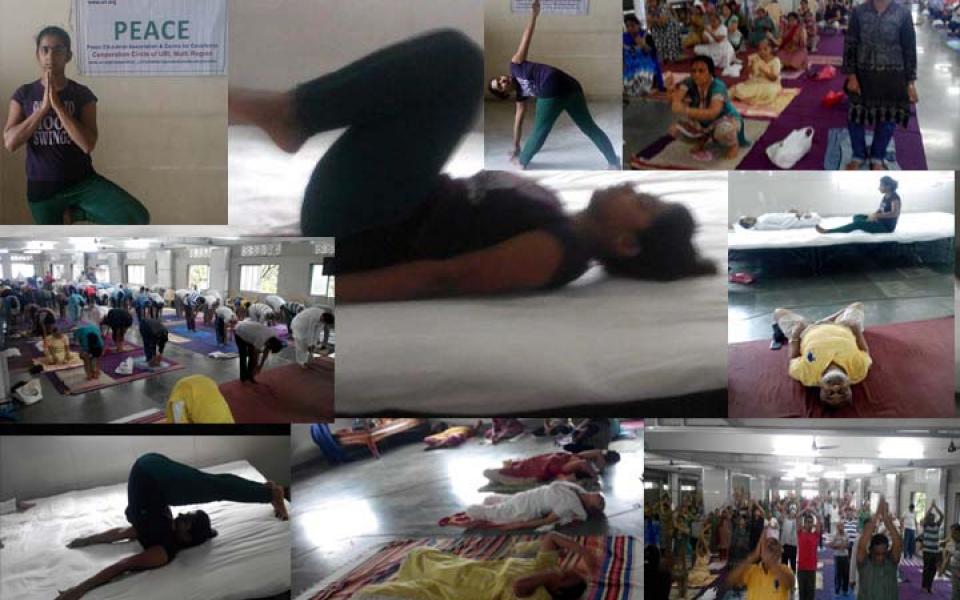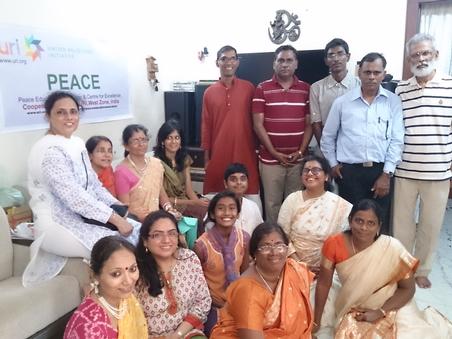
By
Jayanti
Ever since UN announced June 21st, as the International Yoga day, several yoga enthusiasts around the world from different countries were gearing up and preparing to celebrate for the first time a special day dedicated to purify one's Body, mind and spirit. So in a way, this was the day to practice 'You become the change to see the change around you' echoed by Mahatma Gandhi. India being the seat of sages and saints who propounded and promoted yoga systems for ages for the welfare of whole world, took the lead and it is noticed that yoga is practiced daily by all those who are convinced of its holistic benefit for self and as part of social welfare. The practitioners belong to different traditions, religion and caste establishing the universality of yoga systems. This was also validated when several countries took part to celebrate UN yoga day.
Bhumi Shah, our youth member is an avid yoga promoter as part of her hobby and passion. She recently completed her B.Tech with distinction from S.P. Engineering College, one of the best campuses for engineering stream in India and is very busy with her new job. Still it didn't stop her from sparing some time for celebrating UN Yoga day. With the support of her father, Mr. Satish Shah, they organized the yoga event for their Jain community in their community hall near the western suburbs of Mumbai.
Yoga means connection or union. If practiced properly with conviction, it will connect inner self with higher self or higher force leading to Self realization and inner peace. All seers from all traditions accept that working towards inner peace is the best way to promote external peace in the world. In this spirit, we appreciate the slogan "Yoga for combating Violence" coined by Dr. Abraham Karickam and we need to carry the slogan forward by promoting yoga amongst all strata of society.
Bhumi Shah in her workshop sessions systematically presented the features of yoga systems.
Following is a short report from Bhumi Shah.
The International Yoga day was declared to realize the importance of Yoga in living a healthy and balanced life. The longest day of the year- 21st June was chosen for celebrating this day all over the world, so that one gets maximum benefit of solar rays.
In order to promote this spirit of Yoga, we organized a community event in Mumbai.
A total of 150 people attended and benefitted from the three hour workshop event, making it successful.
The day started with the discussion of the meaning and purpose of the science of Yoga.
- What is Yoga?
Sage Patanjali- who wrote the Patanjali Yoga Sutras (196 aphorisms), described it as a state of- “Chitta Vrutti Nirodha” meaning purification of mind.
- How to achieve this state?
Patanjali Yoga Sutra propounded Astanga yoga- or the eightfold system of yoga for the purification of body, mind and spirit. There is yoga for body, yoga for mind and yoga for spirit, by practicing which one can discipline oneself.
Astanga yoga consists of Yama, Niyama, Aasan, Pranayam, Pratyahar, Dharna, Dhyan and Samadhi. These are regarded as the eight steps on which the entire Yoga science is based. They must be scrupulously followed under the guidance of a teacher if one desires to become free from sufferings of body and mind and attain inner peace.
Yama: The social restraints or social and ethical discipline. It involves self-purification and abstinence. They are Ahimsa (non-violence and love for all beings), Satya (noble truth which does not cause any harm), Asteya (non-stealing), Aparigraha (non-possessiveness or contentment with whatever one has or non-grabbing) and Brahmacharya (celibacy or controlling senses).
Niyama: it is the observance of right discipline through Sauch (cleanliness), Santosh (contentment), Tapa (penance), Svadhyay (to study and reflect over scriptures) and Ishwar Pranidhana (to pray and offer the fruits of one’s deeds to God). Through Niyama, one can practice peace both outwardly and inwardly.
Asana: Sage Patanjali has defined it as ‘Sthiram Sukham Asanam’ which means, the posture which can be maintained for a long time without difficulty. A collection of asanas which help in attaining steadiness, form a part of Yoga.
Pranayam: The practice of controlling the rhythm of breathing in and out.
Pratyahar: to detach the mind and the senses from objects of desire and to use them to understand the Self. Through it, a yogic disciple can achieve control over his/her senses.
Dharana: to meditate on a particular object, for eg. a body part, an idol, a mantra word or syllable, a source of light or breath. This leads to complete concentration of mind.
Dhyan: the constant progress in Dharana is called Dhyan. When a yogic disciple can maintain his focus on an object for a long time, he/she attains a control over the mind.
Samadhi- when the observer, observation and the object become unified, the state of Samadhi is said to have been achieved. At this point, the flow of thoughts through the mind is completely stopped and union is achieved. Here the purpose of Yoga is realized and one is enlightened.
After giving basic introduction to yoga, we began the demonstrations. It started with the movement of each joint to loosen it up. This was followed by asanas in standing, sitting and sleeping position. After our demonstrations, the audience was asked to do it.
After basic yoga postures, we jointly practiced Pranayama (breathing exercises), followed by few minutes of silent meditation. The last part of session was a prayer in unison for the peace and well being of all in earth planet. There was calmness after that and a general feeling of freshness and rejuvenation was experienced by each and everyone.
The audience was an assorted crowd covering youth, women, men and senior citizens and all took interest to perform the yoga postures. It is encouraging to me that URI is promoting health education through yoga. As its member, I am looking forward to organize more such events in the future.
See more URI celebrations from International Yoga Day.


